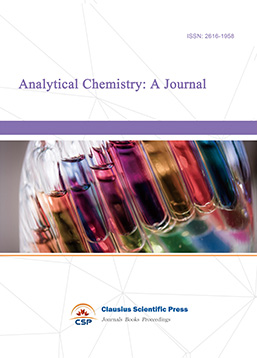Construction of molecularly imprinted electrochemical sensor and penicillin detection based on FeS2@C
DOI: 10.23977/jmpd.2021.050105 | Downloads: 14 | Views: 1814
Author(s)
Junfeng Yang 1
Affiliation(s)
1 School of chemistry, Nanchang University, Nanchang, Jiangxi, 330031
Corresponding Author
Junfeng YangABSTRACT
This paper proposes for the first time a molecularly imprinted electrochemical sensor (MIECS) based on graphene-loaded FeS2@C modified glass electrode (GCE) for the efficient, rapid and sensitive detection of penicillin (PNC). Iron disulfide coated with biomass carbon has a very high specific surface area and volume effect, excellent electron transfer efficiency and conductivity, and is used to modify electrodes.In the experiment, electropolymerization was employed, with penicillin as the template molecule and o-phenylenediamine as the functional monomer, and the imprinted polymer membrane was successfully anchored on the surface of the FeS2@C composite material to specifically adsorb and detect penicillin. The materials were characterized by XRD, CV, DPV and other characterization methods. At the same time, CV and DPV were used to optimize the experimental conditions such as the molar ratio of functional monomer and template, elution time, resorption time, the number of polymerization cycles, and pH. In the end, it is concluded that under the experimental conditions of pH=3, molar ratio of 1:5, and polymerization circle number of 20, MIECS has good sensitivity, selectivity, reproducibility and stability to PNC.
KEYWORDS
FeS2@C, Molecular imprinting, Electrochemical sensors, PenicillinCITE THIS PAPER
Junfeng Yang. Construction of molecularly imprinted electrochemical sensor and penicillin detection based on FeS2@C. Journal of Materials, Processing and Design (2021) 5: 23-30. DOI: http://dx.doi.org/10.23977/jmpd.2021.050105
REFERENCES
[1] Yang H, Sun Y R, Cai R, et al. The impact of dietary fiber and probiotics in infectious diseases [J]. Microbial Pathogenesis, 2020, 140: 103931.
[2] The first weapon for human treatment of bacterial infections--penicillin.. Xinhuanet. 2014-05-12
[3] Li X, Li F, Kang H B. Progress in the detection of ampicillin residues in animal-derived foods [J]. Food Industry, 2021, 42(02).
[4] Chen J, Li H, Chen Y Q, et al. HPLC quickly determined the content of orange penicillin in red curvature [J]. Journal of Fujian Normal University (Natural Science Edition), 2020, 36(05).
[5] Bol'shakov D S, Amelin V G, Nikeshina T B. Determination of antibiotics in drugs and biological fluids using capillary electrophoresis [J]. Journal of Analytical Chemistry, 2016, 71(3): 215-233.
[6] Lei X L, Xu L G, Song S S, et al. Development of an ultrasensitive ic-ELISA and immunochromatographic strip assay for the simultaneous detection of florfenicol and thiamphenicol in eggs [J]. Food and Agricultural Immunology, 2018, 29(1): 254-266.
[7] Martins Y A, De Oliveira C L C G.Measurement of ampicillin residues in milk by quantum dot fluorescence immunity [J]. Journal of Applied Spectroscopy, 2019, 86(4): 629-635.
[8] Zhu W X, Yue X Y, Duan J Y, et al. Electrochemically co-reduced 3D GO-C-60 nanoassembly as an efficient nanocatalyst for electrochemical detection of bisphenol S [J]. Electrochimica Acta, 2016, 188: 85-90.
[9] Li H, Zhang Z, Duan J, et al. Electro-chemical disinfection of secondary effluent from a wastewater treatment plant: removal efficiency of ARGs and variation of antibiotic resistance in surviving bacteria [J]. Chemical Engineering Journal, 2020, 392: 123674.
| Downloads: | 4088 |
|---|---|
| Visits: | 253395 |
Sponsors, Associates, and Links
-
Forging and Forming

-
Composites and Nano Engineering

-
Metallic foams

-
Smart Structures, Materials and Systems

-
Chemistry and Physics of Polymers

-
Analytical Chemistry: A Journal

-
Modern Physical Chemistry Research

-
Inorganic Chemistry: A Journal

-
Organic Chemistry: A Journal

-
Progress in Materials Chemistry and Physics

-
Transactions on Industrial Catalysis

-
Fuels and Combustion

-
Casting, Welding and Solidification

-
Journal of Membrane Technology

-
Journal of Heat Treatment and Surface Engineering

-
Trends in Biochemical Engineering

-
Ceramic and Glass Technology

-
Transactions on Metals and Alloys

-
High Performance Structures and Materials

-
Rheology Letters

-
Plasticity Frontiers

-
Corrosion and Wear of Materials

-
Fluids, Heat and Mass Transfer

-
International Journal of Geochemistry

-
Diamond and Carbon Materials

-
Advances in Magnetism and Magnetic Materials

-
Advances in Fuel Cell

-
Journal of Biomaterials and Biomechanics


 Download as PDF
Download as PDF